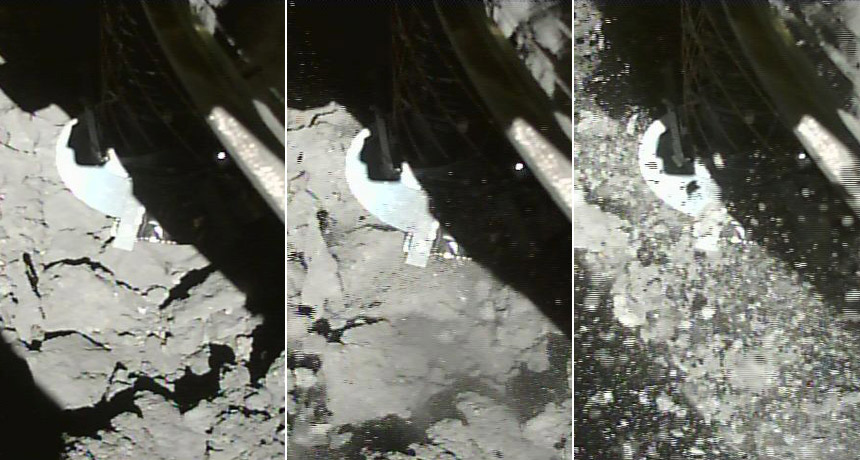Hayabusa2 may have just snagged bits of asteroid Ryugu’s insides

The Hayabusa2 spacecraft has made its second and final attempt to grab a pinch of dust from asteroid Ryugu. At about 9:06 p.m. EDT on July 10, the Japanese spacecraft briefly touched down near an artificial crater it had previously blasted into the 4.5-billion-year-old asteroid’s surface. If the dust grab went well, it’s the first spacecraft to ever collect a sample from an asteroid’s insides.
“We’ve collected a part of the solar system’s history,” said project manager Yuichi Tsuda, of the Japanese Aerospace Exploration Agency, at a July 11 press conference.
Hayabusa2 first successfully touched down on Ryugu’s surface on February 22, after months of experiments on Earth to make sure the spacecraft’s sample collection technique would work on the asteroid’s surprisingly rocky surface (SN Online: 2/22/19). The strategy involves firing a tantalum bullet at close range into the surface to kick up surface dust and then catching some of that dust in a long, flared horn (SN: 1/19/19, p. 20).
In April, the spacecraft dropped a two-kilogram copper cylinder from about 500 meters above the asteroid to blast an artificial crater about 10 meters wide and 2 meters deep into its surface (SN Online: 4/26/19), in preparation for the second sample retrieval. Its goal: to stir up buried material that hasn’t seen sunlight for up to billions of years.
“Touchdown is a high risk operation,” the team wrote on its website July 8 in preparation for the second sample retrieval. “Just because we have succeeded in the past does not mean we can easily do so again.”
The Japanese space agency decided to aim Hayabusa2 at an area about 20 meters north of the crater’s center, where it looks like dark material from inside the crater landed. After hours of descending toward the asteroid’s surface, Hayabusa2 briefly tapped the targeted spot and fired the bullet, creating a spray of pebbles. The spacecraft immediately started to rise again. At 9:51 p.m. EDT, mission control received word that the spacecraft was safe.
“The state of the spacecraft is normal and the touchdown sequence was performed as scheduled,” the team tweeted. “Project Manager Tsuda has declared that the 2nd touchdown was a success!”
Hayabusa2 will leave Ryugu in November or December, and is expected to arrive back at Earth in 2020. That’s when the team will confirm that the spacecraft successfully collected the dust. Studying material from the asteroid’s surface and subsurface will let scientists tease out details of the asteroid’s history and the early history of the solar system (SN: 4/13/19, p. 11).